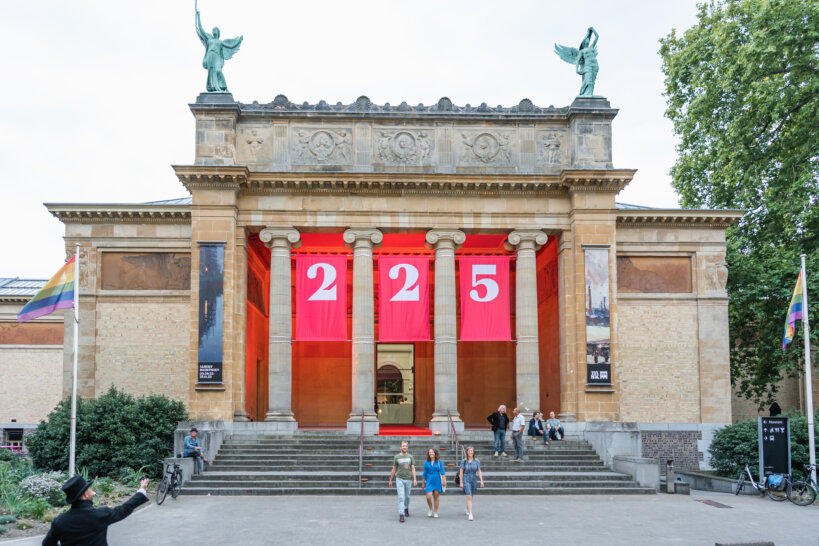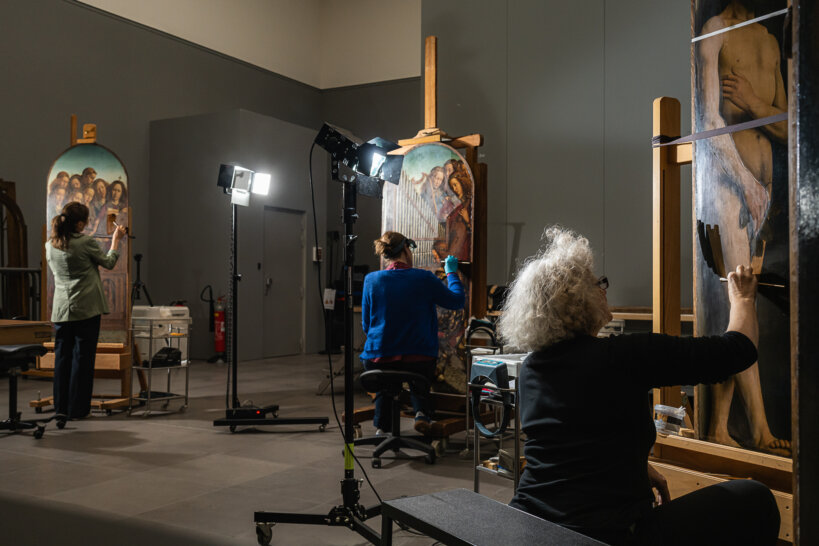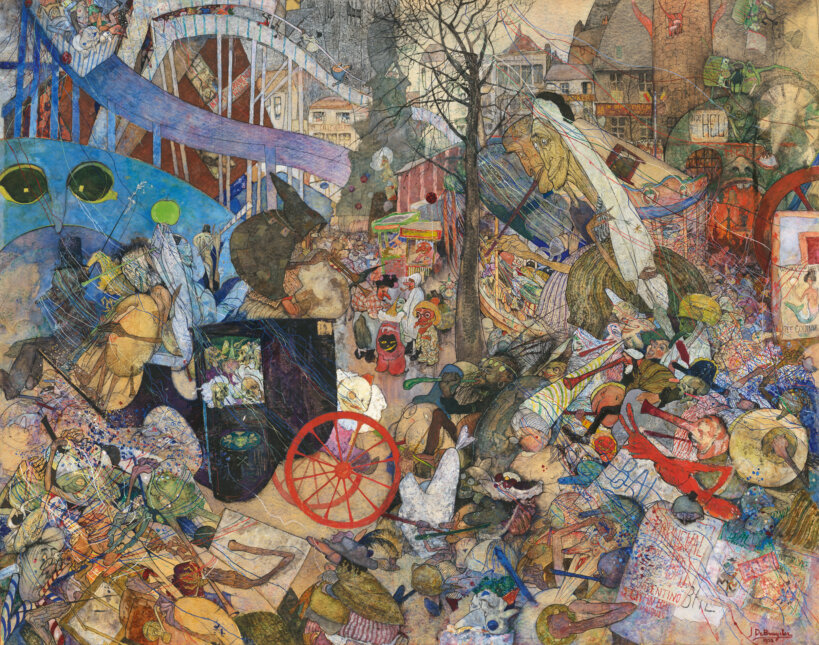In 2023, the MSK celebrates its 225th anniversary. That makes us officially the 'oldest museum in Belgium'! The Friends of the Museum turned 125 in 2022. We're celebrating both anniversaries in one big cultural festive year with two major exhibitions, a new thematic trail through the galleries and art projects in the city.
| What | Historical trail, exhibitions, events and art projects |
| Where | At the museum and across the city |
Exhibitions
MSK 225: historical trail
Get to know all about 225 years of MSK and the ins and outs of an art museum through collection pieces, a thematic audio guide and multimedia applications.

Taking the collection outside
The 225th anniversary of the museum was the occasion for a large participatory project with and for the inhabitants of Ghent. You could find the results throughout the year in the city and in the museum galleries.

225 years of MSK, also in the shop!
At the beginning of 2022, we invited Ghent-based makers to design an original shop product inspired by the MSK collection. From the many submissions, 9 designers (including 1 duo) were selected. The designs are for sale in our shop!

125 years The Friends
This year, we celebrate twice. Next to our 225th birthday, it has also been 125 years since The Friends of the Museum were found. This makes it the oldes association of friends, together with the Friends of the Louvre.

Some activities part of MSK 225
→ see allArtistic city tours
The history of the MSK is closely intertwined with the history of Ghent. Especially for the anniversary year we've published a walking guide to artistic Ghent. Discover the stories that lie behind the facades at your own pace, or take part in the guided city walks.

1770
The Ghent drawing school run by painter Philippe Charles Marissal becomes the 'Académie Royale de Dessin, Peinture et Architecture'. From 1792 on it holds biannual salons and competitions. Works from the Academy remain in the museum collection even today, but it was not initially intended to be a museum.
1792
Ernest Joseph Bailly wins the Academy’s first art competition with his work 'Contempt of hatred', which can still be seen in the museum.
1798
When France takes over the Southern Netherlands, Ghent also comes under French rule. Churches and convents are systematically dissolved and their art falls into the hands of the state. Many of these works are assembled in a public collection in Ghent, first in the Baudelo Monastery and later in Saint Peter’s church. It is here that the 'Musée du Département de l’Escaut' - the oldest art museum in what would later become Belgium - is established on 9 September 1798.
1802
The museum opens its doors to visitors on 22 November 1802 with a collection consisting mainly of 17th-century Flemish paintings, and this changes very little in the ensuing years. New works from Ghent’s city hall are added to the collection, some minor works are sold off, and a series of religious paintings are returned to the churches from which they were originally removed.
1811
The 'Musée de l’Académie' opens in an upstairs gallery of the Augustinian monastery. The museum is now a designated municipal institution. Art students come to study and copy the works of their predecessors, and rules are set out to ensure that they behave themselves in the museum.
1830
The Northern and Southern Netherlands are divided again on 20 December 1830, with Leopold I appointed as the first King of sovereign Belgium on 21 July 1831.
1835
The museum purchases its first work by a living artist: 'Auction of Seized Goods' (1835) by Joseph Geirnaert. Starting in the second half of the 1830s, the city of Ghent begins acquiring contemporary works of art for the museum, mainly selecting them at the tri-annual salons of Brussels, Antwerp and Ghent. They reflect the conservative, late-romantic tastes of the time.
1860
The museum purchases its first work by an Old Master: the 'Allegory of the Five Senses' (1632) by Theodoor Rombouts. The work depicts the five senses as rustic figures engaged in everyday activities. This painting continues to be a firm favourite among museum visitors even today.
1860-1900
A major trend for French art develops in the period from 1860 to 1880. From 1890 on the museum begins to acquire works by conservatively modernist artists, such as Emile Claus and Anders Zorn. Women, the working class, Ghent residents and tourists find their way to the museum. Benches are provided, opening hours are expanded and the museum organises various activities.
1897
Two prominent Ghent residents, Fernand Scribe and Georges Hulin de Loo, establish the Society of Friends of the Museum of Ghent. The association purchases works by artists who have died at least 50 years previously. Even before World War I, the Friends help the museum acquire some absolute masterpieces, including 'Christ Carrying the Cross' by Jheronymous Bosch and 'Jupiter and Antiope' by Anthony van Dyck.
1898
The city decides to commission a new building in which the collection can be seen at its best. Architect Charles Van Rysselberghe, brother of painter Théo Van Rysselberghe, designs an ingenious buildingon a human scale. Every gallery admits sunlight, and the floor plan is varied yet simple. A site for the building is chosen at the edge of the city, in the Citadel Park.
1908
The Friends of the Museum buy the 'Portrait of a Kleptomaniac' by Théodore Géricault at a public auction in Paris. It is one of the five remaining portraits of mentally disturbed people - the so-called monomaniacs - that Géricault painted at the hospital La Salpêtrière in Paris. 'Saint Jerome' is also purchased: one of only about 25 works attributed with certainty to Jheronymus Bosch.
1911-1913
For the Ghent World’s Fair of 1913, the museum is expanded with a U-shaped addition and two semicircular wings, doubling its floor space. The museum hosts the exhibition 'L’Art ancien dans les Flandres'.
1914
Upon his death, Fernand Scribe donates his entire private collection to the museum, including works by Pieter Breughel the Younger, Tintoretto, Jacob Jordaens, Jean-Baptiste Corot, Constant Permeke and Gustave de Smet. This single donation adds over 220 paintings, sculptures and works on paper to the museum’s collection. About 10% of the art permanently on show in the galleries today, originally belonged to Scribe.
1914-1918
The museum closes on 16 August 1914 and the German army’s pharmaceutical service occupies the cellars (the current site of the office wing). The building suffers heavy damage throughout the war years.
1940-1945
To protect it from damage and theft during the war, the entire museum collection is moved to Pau, in the South of France. The building again suffers serious war damage.
1957
The Society for the Museum of Contemporary Art is founded in order to keep pace with developments in the world of contemporary art, as its members feel this is not adequately represented in the MSK.
1975
The Museum of Contemporary Art is established as a division of the Museum of Fine Art, with Jan Hoet as its first curator. The new museum occupies ten of the MSK’s galleries for many years, until the S.M.A.K. opens its doors on the other side of the street in 1999.
1999
The Flemish government recognises the MSK as a national museum.
2002

2003
The Flemish Masterwork Decree, intended to ensure that valuable Flemish heritage cannot be permanently removed from the country, takes effect on 24 January. Today the MSK collection includes around 50 of the works that are named in the Flemish Masterwork Decree, some of which are on display in the galleries.
2003-2007
In September 2003 the museum closes for major renovation work. The facades are cleaned, the roof and floors restored, and the office wing updated. At the same time, modern technologies are installed to manage humidity, temperature, lighting and security. Part of the collection remains on display at various locations in Ghent, including in the crypt of Saint Bavo’s Cathedral and the Leopold Barracks.
2008
Belgian artist Raoul De Keyser donates 187 works on paper to the MSK. He believes that the museum is the best place for these works, created between 1964 and 1979, due to its expertise in conserving works on paper and organising exhibitions of prints and drawings.
2012-2019
The outer wings and five lower panels of the Ghent Altarpiece undergo restoration in the MSK, carried out by the Royal Institute for Cultural Heritage (KIK-IRPA). Visitors can watch the work behind a glass partition. The restoration shines new light on the altarpiece, as 40% of it is revealed to have been painted over.
2014
The Autonomous Municipal Entity for Art and Design is founded, uniting the administrative bodies of the MSK, S.M.A.K and Design Museum Ghent. The newly created Autonomous Municipal Entity for Heritage is also founded to govern the StaM, MIAT (now known as the Museum of Industry) and Huis van Alijn.
2016
Art collectors Jozef and Fernand De Blieck make an extraordinary donation of 25 rare paintings and sculptures to the MSK. These are mainly by artists who worked in Sint-Martens-Latem and the Leie region. Read more on this donation.
2017
Artist Patrick Van Caeckenbergh donates 'The cigar box' to the MSK. Formerly his work space, this is now an inspired work of art that occupies a central place in the museum.
2018
The museum goes through a difficult period at the start of the year due to a controversial loan. In the spring, however, the team can once again fully focus on organising the exhibition 'Van Eyck. An Optical Revolution', scheduled for 2020.
2020
The MSK organises 'Van Eyck. An Optical Revolution', the biggest exhibition in the museum’s history. It attracts international media attention and brings visitors to Ghent in huge numbers, before the COVID-19 pandemic forces its closure after six weeks. It is awarded the prestigious Apollo Award for Exhibition of the Year.
2022-2023
The MSK launches a year of cultural festivities in celebration of its 225th anniversary and the 125th anniversary of the Friends of the Museum.
















































